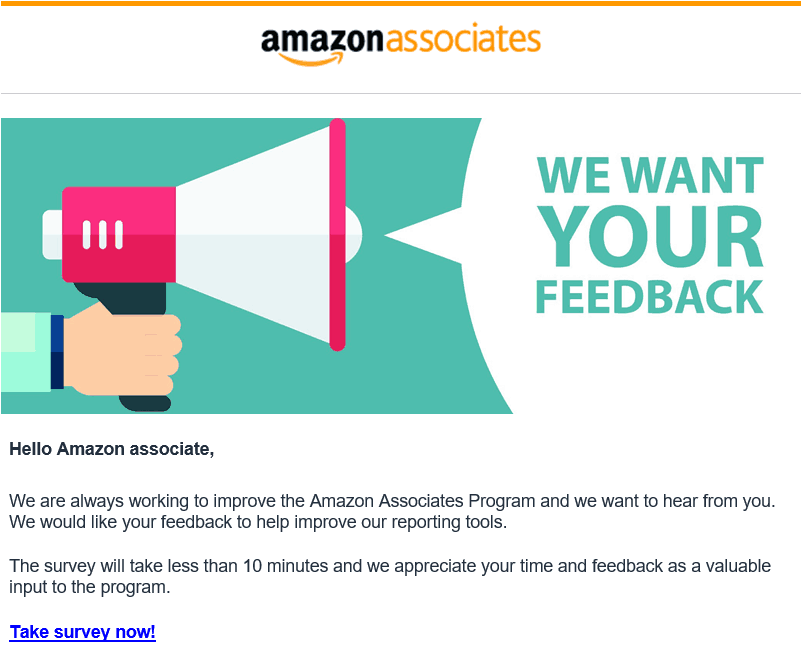For many years I have been following how Amazon uses affiliate marketing (through their Associates Program) to grow its business, drawing attention to noteworthy changes within their affiliate program, analyzing Amazon’s approach in my writing and conference presentations, and even trying myself as an Amazon affiliate.
Yesterday afternoon I was excited to see Amazon send out an email to its affiliates inviting them to participate in a feedback survey. The aim of the latter was stated as experience improvement “for everyone involved in the program.”
The situation was all the more special because this was one of very few affiliate-oriented surveys ever run by Amazon.
Being a firm believer in continuous learning from others, I couldn’t miss this excellent chance to put my “critical student” hat and see what can be learned from how this survey was handled. There are five specific lessons that affiliate program managers may draw here. I am listing them below, using action verbs for each.
1. Ask
One of the easiest, yet commonly overlooked, ways to find improvement opportunities for your affiliate program is to involve your own affiliates in the process. Instead of assuming what they need, seek their feedback to uncover what they are missing. By involving affiliates in “improving” their program, Amazon is setting a great example here.
2. Incentivize
Take a look at how Amazon’s invitation was worded:
Was it missing anything? You got it! There was no incentive for the affiliate to click on that “take survey” link and spend their time on helping the advertiser improve their business. This is way too reminiscent of the Kohl’s customer survey that I described on this blog nine years go. We’ve seen a much better response rate to affiliate surveys when they are coupled with a tangible motivator. You would be surprised how much a $5 Starbucks gift card could “buy” you when used as an incentive!
3. Don’t Rush
Amazon’s affiliate survey contained over 20 questions and took me around 7 minutes to complete. It wasn’t bad at all and corresponded to that “less than 10 minutes” expectation that Amazon set in the original invite. One thing that I did notice, though, was that the slower the progress bar changed, the less time I was spending on answering questions – especially the open-ended ones. Digging a bit deeper into researchers on surveys, I discovered that I wasn’t alone. In one study, experimental data (based on some 100,000 randomly selected online surveys) confirmed that “the longer a survey is, the less time respondents spend answering each question”:
If you want more thoughtful answers, you may want to consider shorter surveys – avoiding potentially harmful respondent’s hastiness.
4. Make It Easy
A really cool feature that Amazon used on a couple of their survey questions allowed affiliates to drag and drop (suggested options) to express their priority preferences. One question, however, contained a bit too many things to prioritize – thirteen, to be exact.
![]()
I must confess: I was only able to prioritize only about one-third of the suggested options (those that resonated the most with me), leaving the rest as is. I have a feeling that others may have selected and ranked just their top three or four preferences; and if so, Amazon will end up with a lot of distorted data – especially on the lower-ranked half of the options.
5. A/B Test
Overall, this pretty thorough and well-thought-out survey was a bit too long to my liking, but only A/B testing (involving surveys of different lengths) could show how length influences completion rates. In the affiliate programs that we manage, we have had great success with one-page surveys containing four of five questions. Split test to arrive at the optimal length of your surveys.
As always, your comments are most welcome! So if you have anything to add, please do use the space under this post and I guarantee that we’ll turn it into a dialogue.
